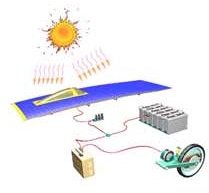Solar energy as Alternate Vehcile Fuel: How Solar Cars Work?
We know about solar energy being used as an alternative to electricity, but solar power as an alternative to fuel??? May be a little new on the ears to listen, but it is already implemented. Scientists all over the world are thinking about various alternatives to be used in place of fossil fuel, because of their fast depletion and also since they are a major contributor to pollution.
Just like using hydrogen, methanol and other bio-diesel as fuels for automobiles, people all over the world are contemplating about the use of solar energy as fuel for automobiles.
The working of a solar car would be very similar to the working of solar systems that are used as a substitute for electricity in many house holds. Solar panels are made up of semi conductors. Solar energy consists of particles called as photons. These photons are captured by the solar panels in what is called as photovoltaic cells. The panel then converts the captured solar energy into electricity.
Generally this energy is stored in batteries for efficiency and flexibility. A control system is used to regulate the power that goes to the electric drive motor, like the accelerator in a car.
But unlike conventional cars, solar cars store the energy absorbed when braking rather than wasting it entirely to heat and noise.
The design and use of solar cars requires an approach that is radically different because of the limited power available to them. There would be a vast degree of variation from the traditional cars that uses fossil-fuel vehicles, with their relatively unlimited power. Aerodynamics and the weight of the automobile become significant design issues.
In order for the solar panels to achieve a good level of efficiency and constant supply of solar energy, solar panels require large area for installation. And hence batteries that are needed to store the sun’s energy in the form of electricity are a large part of the weight in solar cars.
Without batteries, the car would definitely have difficulty with accelerating, climbing hills, overtaking cars, and in conditions where direct sunlight is obscured clouds, and during dusk.
The most economical and widely used batteries are lead-acid car batteries. A typical solar car would have anywhere from five to ten of these. Although advances have been made in battery technology, the ratio of how much energy these can store in comparison to their weight is not as good as for fossil fuels.
With solar cars, there is very little excess power to play with, so conveniences like heaters and air conditioners need careful thought.
It definitely does not come as a surprise when I say that solar cars are environmentally friendly and have zero emissions. But unfortunately at the moment, the efficiency of the photovoltaic cells is extremely limited. But as the time progresses, the efficiency of these photovoltaic cells with definitely improve. This will definitely make solar cars and in turn solar energy the most sought after fuel and car of the future. A sight close to reality in the new few years!
[Img Courtesy solarcar.tafesa.edu.au]
